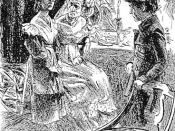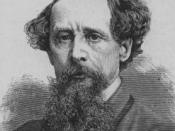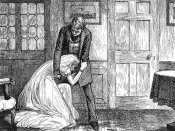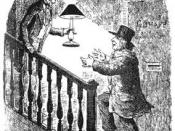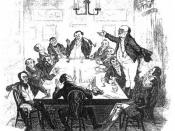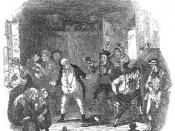Sarah Bacon 4-4-01 Engilsh IV 4st hour Great Expectations is considered Dickens' greatest novel due to his strategies in characterization, style, plot, and theme.
Great Expectations I. Introduction A. Background of Dickens' life B. Thesis statement II. Authentic characters A. Characterization of Pip 1. First person narrative by Pip 2. Change character 3. Romance B. Characterization of main women 1. Miss Havisham 2. Estella 3. Biddy 4. Mrs. Joe III. Style A. Relation of scenery to character's inner thoughts B. Contrast two endings IV. Plot A. Pickwick Papers B. Faultless plot 1. Simpleness 2. Basic lines set early 3. Chief characters set on stage early V. Theme A. Goodness: Product of inner worth 1. Learning hard way 2. Sacrificing C. Sympathies 1. Children and poor 2. Political and social injustices VI. Conclude and restate thesis Sarah Bacon April 30, 2001 Great Expectations Charles Dickens, one of the greatest English novelists of the 1800's, faced much adversity in his youth.
He had seven other siblings, and his father served prison time. At the age of ten, Dickens was working in a factory. His education was limited to a mere two years, and he worked in a lawyer's office for a short time. These life experiences are displayed in several of his novels; however, Great Expectations stands out among these due to various factors. Great expectations in considered Dickens's great novel due to these strategies in characterization, style, plot, and them.
Dickens created a variety of characters. His characters in Great Expectations fit into the story line more so than his other works. They are the most authentic of Dickens's creations. Great Expectations is Dickens's first novel narrated in the first person. Pip, the narrator, is "Dickens' best bit of work"ÃÂ (Gissing 95). Ironically, Dickens never gives the reader a physical description of Pip. He focuses on Pip's inner self in order for the reader to remain focused on the inner qualities of his character. Since the readers fare more intact with Pip's emotions, they acquire a memorable, lasting impression of Pip. Pip, born an orphan, is brought up by his sister, Mrs. Joe Gargery. Unlike Dickens's usual characters, Pip's character changes throughout the novel. "He changes, radically: he moves from a frightened and selfish innocence, to the snobbery and pretense of being a manufactured gentleman, to the wisdom that the convict Magwitch's basic goodness forces on him"ÃÂ (Jacobson 55).
Besides Pip being a tremendous character, so are the women in Great Expectations. The chief women in Pip's life are anything but motherly (Houston 14). According to the critics, Miss Havisham is viewed as a gorgeous female. She hires Pip to play with her adopted daughter, Estella, who is an elegant little girl. Miss Havisham has raised Estella to more or less hate the male sex. This is due to Miss Havisham's previous experience of being stood up on their wedding day. Pip falls in love with Estella, but she does not feel the same way about him. Actually, she has contempt towards Pip. On the other hand, there is Biddy. Like Pip, she is an orphan. Pip and Biddy "have an odd brother-sister-lover relationship"ÃÂ (Partlow 13). They grew up together and are like a brother and sister to one another. As they grow older, Biddy falls in love with Pip. She no longer sees him just as a friend. Pop, however, continually rejects her feelings, and has eventually loses her crush on him and falls for and marries Joe Gargery, Pip's brother in law. This love triangle between Pip, Estella, and Biddy cause4s much misery to Pip. This is Dickens's only romance that he has achieved so accurately in arousing and defeating his reader's curiosity (Charles Dickens: Criticism 1). Another key woman in Pip's life is Mrs. Joe, his sister. Mrs. Joe is the wife of Joe Gargery, a blacksmith. She has raised Pip since his birth. Mrs. Joe is very ill tempered and bossy. She uses Pip to do everything, and she constantly remind him of the trouble he has always caused her. Mr. Joe and Pip are constantly walked over by Mrs. Joe. Her mood gets so out of hand that Orlick, Joe's employee, almost kills her. Dickens does so great of a job at characterization that the reader really feels as if they know the character personally.
In addition to Dickens's terrific characterization, is his ability to in creating a superior style. He had the capability to incorporate the scenery to coincide with the character's inner thoughts. He administers to make the visible setting a part of the mental feeling of the character involved (Jacobson 53). For example, in chapter forty-five, when Pip is residing at Hummus, Pip's feeling and emotions are shown through furniture in the room. At this pint in the story, Pip is very worried and unhappy because of the news of Estella and Drummle's approaching marriage. He hears voices, guitar strings playing, whispering, sighing, and ticking from the chest of drawers, closet, fireplace, and washing-stand in the gloomy and scary room (Dickens 347). All these descriptions allow the reader to feel what Pip is feeling. Also, Dickens used accurate words in his writing, which get the reader involved in feeling the emotions being felt in he story.
Dickens's characters and style would not be extraordinary if his plot were not so outstanding. Dickens's plot for Great Expectations began in his journal known as Pickwick Papers in the magazine called All Year Round. The chief reason for his writing these journals was for fast-earned money. They were written in a series; Dickens always left the reader anxiously awaiting the next publication. Eventually, these publications came together in the novel Great Expectations.
Dickens's plot format in Great Expectations is perfect (Jacobson 52). The plot is very obvious and easy to understand. By the end of chapter eleven, the reader is able to identify all the essential lines and main character of the plot. Dickens's abilities in establishin the plot became better by this novel. "The tendency of his earlier days to let the sup-plot grow to the over-shadowing of the main plot, Dickens had, by now, brought well under control"ÃÂ (Jackson 188). Despite the plot being simple, the reader notes irony and problems. Overall, this plot is fantastic.
The fantastic plot in Great Expectations, however, is different form his other novels in another way. This novel has two endings. The opinion of many people is that the second ending is more extraordinary than the first ending. This would have been Dickens's first gloomy ending, but he allowed another novelist to influence him into creating a delightful ending. The time, scenery, and surroundings are different in the tow endings. First of all, in the forst ending, Pip and Estella are brought back together two years after his return. In the revised ending, however, they are reunited after on day of Pip's return. Also, in the original ending, their meting is set in pure sunshine. Her, they part as friends near a carriage. However, in the second ending, they meet in the dusk of the day, with stars in the misty sky. This romantic scene on a bench allows them to remain with one another. Still today, critics argue over these two endings.
Not to mention all of these factors, Dickens's theme surfaces the novel. "The basic them of Great Expectations is that true goodness does not come form social station or wealth; it comes for inner worth"ÃÂ (Jacobson 50). Many of the character portray this theme, but Pip and sEstella stand out among these. They learn their lessons of the theme by making sacrifices and dealing with consequences. They learn how to be happy with what they have and who they are.
Dickens's basic theme came form his won feelings and experiences with the poor, children, wealthy, and crookedness in the Victorian times. Dickens uncovers the social corruptness of the Victorian times in his novels (Stevenson 154). Dickens had many sympathies towards human nature. Political and social injustices caused his position of being lower of wisdom. He believed that the problems in the system are held by the individual. "One of the important perceptions of Dickens' fiction is of Victorian society as one of which the weak support the strong, the starving underwrite the satiated, the poor prop up the rich, the children sustain the parents and the female upholds the male"ÃÂ (Houston 13). In other words, Dickens focuses on honesty and sin.
Still today, Dickens is recognized as a great novelist, and Great Expectations will always be know as one of this best works. The novel's success is due to his strategies in characterization, style, plot, and theme.
Works Cited "Charles Dickens: Criticism."ÃÂ Biography of Charles Dickens. httpp://galenet.gale.com:888/netacgi/nph, 1996.
Dickens, Charles. Great Expectations. London: Oxford University Press, 1948.
Gissing, George. Charles Dickens, A Critical Study. New York: Haskell House Publishers, 1974 Houston, Gail Turley. "Pip and Property"ÃÂ: The Producton of the Self in Great Expectations."ÃÂ Studies in the Novel. (1992.) 13-25.
Jackson, T. A. Charles Dickens: The Progress of a Radical. New York: Haskell House Publishers, 1971.
